Vietnam has made remarkable progress from implementing its “Doi Moi” (Economic Renewal) process for nearly 40 years, transforming from an underdeveloped economy into a middle-income country and gradually asserting its position as one of the world’s large-scale economies. It currently ranks 32nd globally in terms of economic scale and is among the world’s top 20 countries in international trade and FDI attraction. GDP per capita surpassed the $4,700 mark last year, nearing the threshold for upper-middle-income status.
Notably, according to the Ministry of Finance, GDP in 2025 is projected to reach $510 billion, placing the country 32nd globally and fourth within ASEAN. In purchasing power parity (PPP) terms, GDP in 2025 is estimated at around $1.76 trillion, ranking it 25th in the world. GDP per capita is expected to rise from $3,552 in 2020 to around $5,000 in 2025, while gross national income (GNI) per capita is projected at approximately $4,750, exceeding the lower-middle-income threshold.
Seizing the moment
Amid ongoing global economic volatility and uncertainty, Vietnam has demonstrated strategic foresight by setting ambitious growth targets, aiming for GDP growth of 8 per cent by 2025 and at least 10 per cent annually during the 2026-2030 period. As such, 2025 is seen as a pivotal milestone, laying the groundwork for a breakthrough growth trajectory in the future.
According to Deputy Prime Minister Nguyen Chi Dung, Vietnam’s average annual GDP growth has been around 6.4 per cent over the past two decades, and never reached double digits. Therefore, setting a target of 10 per cent or more is not only an ambitious benchmark but also a bold move for Vietnam to step out of its “comfort zone”. “If we don’t adopt a new mindset or take bold action, we will never realize the targeted double-digit growth,” the Deputy Prime Minister emphasized.
The government’s determination to drive breakthrough growth was evident in the first half of 2025. These included accelerating institutional reforms, streamlining administrative procedures, and strengthening proactive efforts to dismantle barriers facing businesses. As a result, Vietnam’s economic landscape in the first half of the year exhibited several bright spots.
Specifically, GDP growth reached 7.52 per cent year-on-year; the highest first-half result since 2011. Total export turnover hit $219.83 billion, up 14.4 per cent. Registered FDI surged to over $21.51 billion, a 32.6 per cent increase, while disbursed FDI reached $11.72 billion - the highest level recorded for the first half of the 2021-2025 period. “Thanks to these positive results, many domestic and international experts have remarked that Vietnam is ‘swimming against the tide’ - maintaining strong growth momentum while many major economies are still struggling to recover,” said the Deputy Prime Minister.
Reflecting further on Vietnam’s initial achievements and its double-digit growth ambitions, Dr. Nguyen Si Dung, former Deputy Head of the National Assembly Office, affirmed that this is a sound direction aligned with global trends. “In these turbulent times, countries that can adapt quickly, boldly reform their institutions, and strengthen governance capabilities will have the opportunity to rise and lead,” he stressed. “Conversely, those that hesitate, remain passive, or cling to outdated thinking will be left behind, and Vietnam is no exception.”
Bottlenecks remain
Alongside positive outcomes and ambitious growth targets, Vietnam’s recent economic development still faced several limitations that must be seriously acknowledged and addressed. First and foremost, macro-economic stability remains fragile; the quality of growth is improving only slowly, and the transition from extensive to intensive growth remains sluggish, without any clear structural shift. Economic autonomy, workplace productivity, and overall competitiveness remain relatively low.
According to Dr. Dang Duc Anh, Deputy Director of the Institute for Policy and Strategy (IPS), Vietnam’s workplace productivity growth has been inconsistent and is showing signs of deceleration. Specifically, during the 2011-2015 period, it grew at an average of 4.53 per cent a year, then increased to 6.05 per cent a year in 2016-2020 before falling to 4.67 per cent a year between 2021 and 2024.
In addition, emerging growth drivers such as the green transition, the circular economy, the semiconductor industry, AI, new energy, and advanced materials have yet to take clear shape or play a leading role in growth. Meanwhile, traditional drivers are revealing multiple weaknesses, including low investment efficiency, slow growth in the private sector, and a lack of effectiveness in public investment as a catalyst for mobilizing non-State resources.
The foundation for national industrialization and modernization remains unstable. Vietnam still has limited technological autonomy and low localization capacity. Industrial development is mainly extensive, focusing on low-value-added activities such as basic processing, assembling, and subcontracting. High-value stages such as design, creativity, and research and development (R&D) have yet to receive sufficient attention.
Dr. Anh also noted that while the quality of Vietnam’s economic growth has improved over the past decade, the results are still short of expectations. “Workplace productivity growth is slowing, the level of science, technology, and innovation adoption remains low, and the efficiency of capital utilization lags behind the regional average,” he commented.
Furthermore, the shift in the growth model, despite being identified long ago, continues to be slow and lacks cohesion. The transition from extensive to intensive growth faces institutional and policy-related obstacles. The lawmaking process has not kept pace with reality; it remains fragmented, inconsistent, and lacks a long-term strategic vision. As a result, policies struggle to be implemented effectively and deliver a timely impact.
Given its deep globalization, external factors are creating additional challenges for Vietnam’s economy. According to Deputy Prime Minister Dung, the world is increasingly grappling with uncertainty due to more frequent and complex geopolitical and geo-economic shocks. Scientific and technological advancements are fundamentally reshaping economic structures and redefining global value and supply chains. Economic fragmentation and declining trust, driven by strategic competition, are also undermining the role of multilateral cooperation mechanisms.
In addition, non-traditional security challenges, the rise of nationalism, and new trade and regulatory barriers are impeding the path towards sustainable and inclusive development. “All these global challenges are also becoming challenges for Vietnam,” the Deputy Prime Minister emphasized.
Solutions in the new context
Amid the ongoing challenges and structural issues facing Vietnam’s economy, a core question arises: “What must Vietnam do to grow faster and more sustainably and steadily achieve its target of 10 per cent annual growth in the coming years?” In response, many experts believe this is a turning point that requires breakthrough policy decisions, driven by bold reforms and decisive action.
Among the priorities, institutional reform continues to be identified as the cornerstone, serving as the guiding force of the entire development process. Dr. Dung emphasized that institutions are central to development, acting as the “processor” that coordinates all economic and social activities. Rapid growth may stem from capital, natural resources, or cheap labor, but sustainable, innovative, and inclusive growth can only be ensured through a transparent, fair, and effective institutional framework.
According to Dr. Dung, Vietnam must start with a breakthrough in institutional thinking. Institutions are not limited to legal systems and formal regulations but encompass all formal and informal rules governing social behavior. In the short term, he said, Vietnam should focus on amending key foundational laws that remain bottlenecks to development, such as the Land Law, the Law on Investment, the Law on Enterprises, and the Law on Planning. To ensure institutional sustainability, Vietnam must also strengthen policy review mechanisms and improve power oversight systems.
From the perspective of the business community, Mr. Dau Anh Tuan, Deputy Secretary General and Director of the Legal Department at the Vietnam Chamber of Commerce and Industry (VCCI), proposed that to drive rapid and sustainable growth, Vietnam must focus on two key solution groups.
First, the State must innovate its governance approach and continue institutional reform to create a more enabling environment for businesses, especially in production, operations, and innovation. “One key shift is transitioning from pre-approval to post-audit mechanisms, as stated in Politburo Resolution No. 68 on the development of the private economy and Resolution No. 66 on reforming law-making and enforcement activities to meet national development requirements in the new era. Fully applying information technology and enabling data-sharing across ministries would mean businesses only need to submit information once, instead of multiple times,” Mr. Tuan emphasized.
Second, the quality of policy implementation must be improved. While having sound policies is essential, their effectiveness depends on how well they are executed. Mr. Tuan suggested that the government, the National Assembly, and relevant authorities should assign key performance indicators (KPIs) to local governments relating to private sector development and economic growth, and treat these indicators as a critical factor in evaluating political performance.
Beyond core economic areas, energy remains a sector riddled with bottlenecks that must be addressed. According to Mr. Vu Tu Thanh, Deputy Regional Managing Director and Vietnam Chief Representative for the US-ASEAN Business Council, the government must promptly remove barriers in the power sector, starting with lifting quota mechanisms in the National Power Development Plan for 2021-2030 with a Vision to 2050 (PDP8). It should also allow direct power purchase agreements (DPPA) for all types of clean energy, including gas-fired power.
In parallel, Vietnam should accelerate the adoption of advanced technologies, especially AI, to improve productivity and reduce waste. For instance, enhanced weather forecasting using AI is expected to contribute up to 2 per cent to GDP growth. “Importantly, we must ensure equal access for domestic private enterprises, particularly small and medium-sized enterprises, to government-funded investment and procurement projects,” Mr. Thanh added. “These measures will enable the private sector to become the main engine of the economy, as envisioned in Politburo Resolution No. 68.”
However, Dr. Anh cautioned that while the goal of achieving double-digit growth is a necessary endeavor, it must be pursued in alignment with long-term sustainability. To that end, Vietnam must effectively manage five critical areas: ensuring a successful shift in its growth model, maintaining macro-economic stability, improving the business and investment environment, achieving regional and social equity, and integrating environmental protection into development strategies. “Vietnam must take a measured approach when implementing solutions to achieve its double-digit growth target,” he said. “We must avoid becoming a ‘one-season wonder’, focused only on short-term results,” he concluded.









 Google translate
Google translate